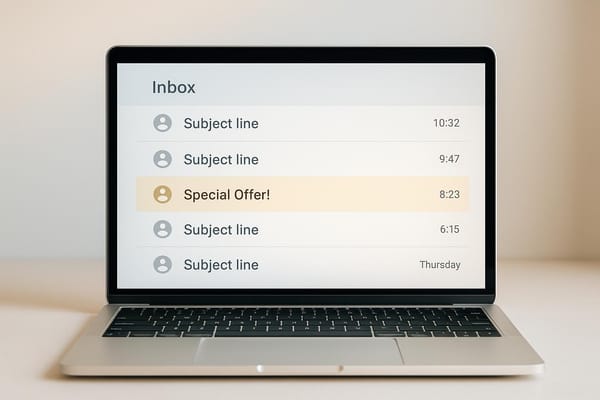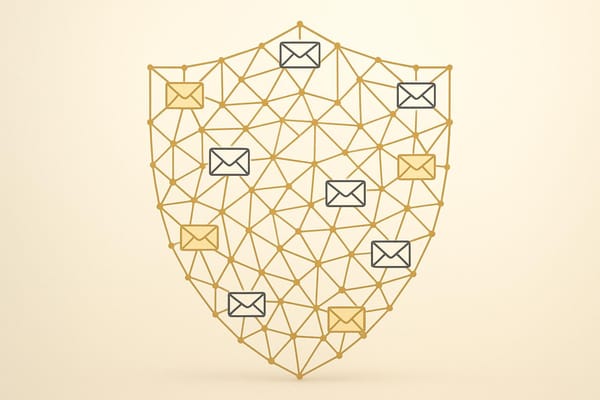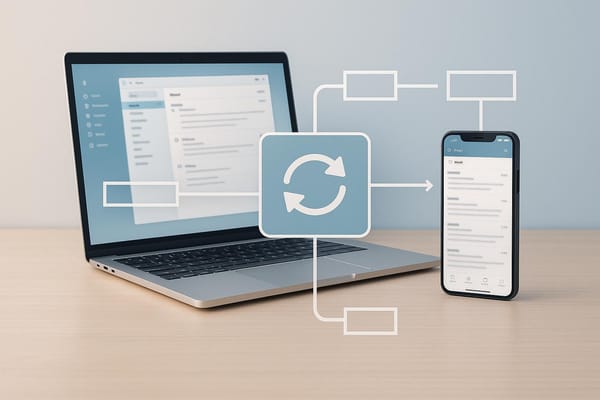How Segmentation Improves Cold Email Deliverability
Segmentation enhances cold email deliverability by improving engagement, reputation, and compliance, leading to more effective outreach.

Segmentation makes cold email campaigns more effective by dividing your audience into smaller, targeted groups. This approach improves email deliverability, engagement, and sender reputation. Here’s why it works:
- Personalization leads to higher engagement: Tailored emails see up to 50% better open rates and 100.95% higher click-through rates compared to generic ones.
- Better sender reputation: High engagement signals to email providers like Gmail that your emails are valuable, keeping them out of spam folders.
- Cleaner email lists: Segmentation helps identify inactive or invalid contacts, reducing bounce rates and spam complaints.
- Compliance made easier: It ensures you only email those who’ve opted in, aligning with U.S. email laws like CAN-SPAM.
For businesses, segmentation is essential to avoid spam filters, maintain a healthy sender score, and boost ROI - up to $36 for every $1 spent on email marketing. The key is combining demographic, behavioral, and lifecycle segmentation to send relevant, timely messages.
Quick Overview
- Challenges in cold email: Spam filters, low open rates, and poor sender reputation.
- How segmentation helps: Personalization, list hygiene, and better compliance.
- Best practices: Regularly clean data, avoid over-segmenting, and follow email laws.
- Tools: Use platforms like Icemail.ai for automated segmentation and email management.
Segmentation isn’t optional - it’s necessary for successful email outreach.
The Ultimate Guide to Cold Email Deliverability in 2025
Common Deliverability Problems in Cold Email Campaigns
Cold email campaigns often face challenges that can prevent your messages from landing in the inbox.
Spam Filters, Low Open Rates, and Reputation Damage
Spam filters are the biggest hurdle for cold email campaigns. These filters analyze your content and sending patterns to detect spam-like behavior. If your emails lack proper authentication protocols or come from IP addresses with a poor reputation, they’re likely to be flagged and sent straight to spam folders.
Authentication plays a key role here. Without correctly configured protocols like DKIM, SPF, or DMARC, your emails are at risk. As Suprava Sabat from @AcquisitionX shared:
"Icemail.ai has transformed how I manage my email infrastructure. The automated setup for Google Workspace accounts, including DKIM, SPF, and DMARC configuration, saved me hours of work." - Suprava Sabat, @AcquisitionX
Low open rates are another major issue. If recipients consistently ignore your emails, providers like Gmail and Outlook interpret this as a sign that your content isn’t worth delivering. Shockingly, 21% of legitimate emails fail to reach the inbox due to problems like poor list hygiene or lack of segmentation. This means one in five of your emails vanishes before it even has a chance to be seen.
Low engagement metrics, such as unopened emails or messages that are quickly deleted, can drag down your sender score. And a poor sender score makes it even harder to get future emails delivered.
Sender reputation damage adds yet another layer of difficulty. If your domain or IP address gets flagged by email providers, rebuilding trust can take months. In fact, 45% of recipients report emails as spam simply because they find them irrelevant or generic. Each spam complaint further tarnishes your sender reputation, creating a cycle that’s tough to break.
When your emails fail to connect with recipients, these issues only worsen - especially if your messages lack personalization.
Why Generic Messaging Fails
Segmentation isn’t just a nice-to-have; it’s a critical tool for improving deliverability and avoiding the pitfalls of generic messaging. One-size-fits-all emails exacerbate every deliverability problem. They fail to address the specific needs of recipients, leaving them feeling like just another name on a mass email list.
The impact of personalization - or lack thereof - shows up in the numbers. Marketers using segmented campaigns see a 14.31% higher open rate and a 100.95% higher click-through rate compared to those relying on generic messaging. Generic campaigns, on the other hand, tend to underperform, dragging down your deliverability metrics.
Recipients can spot mass emails from a mile away. If your message doesn’t address their industry, role, or current challenges, they’re far more likely to delete it or mark it as spam. These actions send negative signals to email providers, which then push more of your future messages into spam folders.
To break this cycle, your communication needs to be tailored to your audience. When prospects receive irrelevant emails, it doesn’t just hurt your deliverability - it can damage your brand’s reputation across all marketing channels. Addressing specific needs and challenges is key to turning things around.
How Segmentation Fixes Cold Email Deliverability
Segmentation addresses the key challenges that often undermine cold email campaigns. Instead of blasting the same message to everyone on your list, segmentation allows you to tailor your communication to specific groups. This personalized approach not only improves engagement but also strengthens your sender reputation.
Targeted Content Gets Better Engagement
Segmenting your audience enables you to craft messages that resonate with their specific needs and challenges. This approach significantly boosts engagement.
Personalized campaigns can increase open rates by up to 50% compared to generic emails. Why? Because relevance matters. For example, a software sales rep targeting Fortune 500 CTOs would use subject lines like "Enterprise Security Compliance for Q1 2026", while small business owners might respond better to "Save 3 Hours Daily on Manual Tasks." These distinct approaches cater to the unique priorities of each group.
Segmentation based on demographics and behavior - like job titles, company size, geographic location, or past interactions - helps you deliver messages that align with where recipients are in their buyer's journey. For instance, someone who downloaded a pricing guide might receive follow-up content about cost breakdowns, while someone who just visited your homepage might get an introductory email.
The impact of this strategy is clear: segmented campaigns generate $36 for every dollar spent, underlining how tailored messaging outperforms generic approaches.
Better Engagement Improves Sender Reputation
Email providers like Gmail and Outlook monitor how recipients interact with your emails. High engagement - such as opens, clicks, and replies - signals that your emails are valuable, which improves your inbox placement.
When your emails are relevant and engaging, ISPs reward you by delivering more of your messages to the inbox instead of the spam folder. This creates a positive cycle: better segmentation leads to more engagement, which enhances your sender reputation, and ultimately improves deliverability.
On the flip side, poor engagement - like emails being ignored or marked as spam - can tank your sender score. This makes it harder for future emails to reach recipients. However, segmented campaigns consistently outperform generic ones. Marketers using segmentation see a 14.31% higher open rate and a 100.95% higher click-through rate compared to unsegmented campaigns.
Keeping Your Email List Clean
Segmentation doesn’t just improve engagement; it also helps maintain a healthy email list by identifying inactive or problematic contacts. By analyzing engagement data, you can pinpoint inactive subscribers or invalid email addresses before they harm your sender reputation.
Here’s how segmentation helps refine your list:
- Removing hard bounces immediately: Invalid email addresses that bounce back damage your reputation. Segmentation makes it easier to spot and remove them.
- Identifying inactive subscribers: Contacts who haven’t engaged in 3–6 months can be moved to a re-engagement campaign or removed entirely.
- Monitoring spam complaints: If certain segments trigger more complaints, you can adjust your messaging to better match their preferences.
- Tracking unsubscribe rates: High unsubscribe rates in specific segments may signal misaligned messaging that needs tweaking.
Poor list hygiene is a major issue - 21% of legitimate emails fail to reach the inbox due to problems like invalid addresses or low engagement. Regularly cleaning your list ensures you’re only emailing people who are genuinely interested, reducing bounce rates and improving deliverability.
Segmentation also supports compliance. For instance, the CAN-SPAM Act requires you to provide recipients with a clear way to opt out. By segmenting based on opt-in status and engagement levels, you can ensure you’re only contacting those who want to hear from you, minimizing the risk of complaints or violations.
These strategies work together to enhance your cold email deliverability, ensuring your messages reach the right audience and drive results.
Segmentation Methods That Work
When it comes to segmentation, three methods stand out: demographic, behavioral, and lifecycle segmentation. Each focuses on a different aspect of your audience, and when combined, they create a well-rounded strategy that boosts both engagement and deliverability.
Demographic Segmentation
This method breaks your audience into groups based on traits like job title, company size, industry, and location. By understanding these characteristics, you can craft messages that resonate with specific realities.
For instance, a CTO might prioritize security and scalability, while a marketing manager could be more interested in lead generation and cost-effectiveness.
Geographic segmentation is especially important for U.S.-based campaigns. Let’s say you’re targeting HR directors - your approach for prospects in tech hubs like San Francisco or Austin might differ from those in manufacturing-heavy regions of the Midwest. Local business cultures, time zones, and market conditions all influence how your message lands. Sending emails during local business hours (9:00 AM to 5:00 PM in the recipient's time zone) ensures your message arrives when it’s most likely to be seen.
Industry-specific segmentation allows you to address sector-specific concerns. A cybersecurity company, for example, might emphasize HIPAA compliance when reaching out to healthcare organizations, while focusing on fraud prevention for financial services. Manufacturing clients, on the other hand, might care more about supply chain security and operational efficiency.
Once you’ve segmented your audience demographically, behavioral segmentation takes things a step further by focusing on how prospects interact with your content.
Behavioral Segmentation
Behavioral segmentation zeroes in on what your audience does, not just who they are. By analyzing engagement data, you can identify top prospects and tailor your follow-up strategy.
Engagement-based segments are a great way to identify high-priority leads. For example, you can create a segment for contacts who opened your last two emails, clicked links, or replied to messages. These individuals are prime candidates for direct, personalized outreach. Meanwhile, those who haven’t engaged in over 30 days might benefit from educational or value-driven content to reignite their interest.
Website behavior integration goes beyond email metrics. If someone visits your pricing page but doesn’t convert, they belong in a different segment than someone who merely skimmed a blog post. A prospect who spends 10 minutes on your case studies page is far closer to making a decision than someone who bounces after 30 seconds.
Response pattern segmentation helps you tailor your messaging style. Some prospects prefer detailed, technical content, while others appreciate concise summaries. If a contact consistently interacts with ROI calculators or pricing information, they’re likely in evaluation mode and ready for sales-focused outreach.
To make this process smoother, set clear thresholds for engagement levels. For example:
- Highly engaged: Opened at least one email in the last 30 days and clicked a link.
- Moderately engaged: Opened emails but didn’t click.
- Inactive: No engagement in over 60 days.
These definitions allow you to automate workflows that adjust messaging based on behavior. Next, lifecycle segmentation adds another layer by aligning outreach with where prospects are in their buyer journey.
Lifecycle Segmentation
Lifecycle segmentation ensures your messaging aligns with a prospect’s current stage in the buyer’s journey. This approach prevents pushing too hard - or too gently - at the wrong time.
New leads need nurturing, not hard sells. Focus on building trust with educational content like industry insights, best practices, or case studies that address initial interests. Jumping straight to product demos or pricing discussions can alienate them.
Marketing-qualified leads (MQLs) have shown enough interest to warrant more targeted outreach. These prospects might have attended a webinar, downloaded multiple resources, or spent significant time on your site. They’re ready for more specific product information but still need a nurturing approach rather than aggressive sales pitches.
Sales-qualified leads (SQLs) are actively evaluating solutions. These prospects are engaging with sales-focused content, requesting demos, or asking detailed questions about implementation. At this stage, your messaging can shift to competitive advantages, ROI calculations, and next steps.
Lapsed contacts offer opportunities for re-engagement. Someone who was highly active six months ago but has since gone quiet might have faced budget constraints or shifting priorities. A thoughtful “checking in” email that acknowledges the gap and offers updated information can be more effective than ignoring the silence.
Existing customers require a completely different approach. They already trust your brand, so your focus should be on upselling, cross-selling, or renewal campaigns. Highlight ways to expand their usage or introduce them to additional solutions.
By aligning your messaging with each stage of the buyer’s journey, you ensure your outreach feels relevant and timely. For instance, a brand-new lead isn’t ready for in-depth case studies, but a prospect in the evaluation stage might find them invaluable. This alignment not only improves engagement but also builds trust through thoughtful pacing.
Bringing It All Together
When you combine demographic, behavioral, and lifecycle segmentation, you create a strategy that addresses three critical questions: who your prospects are, how they behave, and where they are in their journey. This layered approach makes your emails feel more relevant and valuable, leading to better engagement and improved deliverability. By taking the time to segment effectively, you’re not just sending emails - you’re building connections.
Tools to Automate Your Segmentation
If you’re working with a small contact list, manual segmentation might do the trick. But as your list grows into the thousands and spans multiple campaigns, manual efforts can quickly fall short. That’s where automation steps in. The right tools not only save time but also improve accuracy, ensure better deliverability, and simplify infrastructure management.
Automated vs. Manual Segmentation
At first glance, manual segmentation might seem like a cost-saving option. But it doesn’t take long for it to become a major bottleneck. Manually updating spreadsheets and managing contacts is fine for a small list, but as your audience grows, this approach becomes inefficient and prone to errors. Automation, on the other hand, integrates directly with your CRM, website analytics, and email platforms. It tracks engagement in real time and adjusts segments automatically based on user behavior.
For instance, if a prospect clicks on a pricing link, automation can instantly move them into a "sales-ready" segment. This reduces human error and ensures your segments stay up-to-date without constant manual intervention.
Another big advantage is scalability. While manual segmentation struggles to keep up as your contact list expands, automated tools can handle large volumes effortlessly. Plus, they eliminate the need for extra labor, making them essential for growing campaigns. This is where platforms like Icemail.ai shine.
Icemail.ai: The Premium Solution

Automation is great, but Icemail.ai takes it to the next level. Designed for U.S. businesses aiming for top-tier deliverability, this platform combines advanced segmentation with seamless infrastructure management, giving you both strategic and technical advantages for cold email success.
One standout feature? The platform’s 10-minute onboarding process. Instead of spending hours configuring domains and mailboxes, Icemail.ai automates the entire setup. This rapid onboarding is perfect for time-sensitive campaigns or businesses scaling quickly.
Icemail.ai also simplifies bulk mailbox setup and DNS management, which are often tedious and error-prone tasks. You can purchase and configure multiple Google Workspace or Microsoft mailboxes at once, using separate accounts to isolate sender reputations. This means one underperforming campaign won’t drag down your entire email system.
On top of that, Icemail.ai automates the setup of critical DNS records like DKIM, DMARC, and SPF. These records are essential for email providers to verify your sender legitimacy. The result? A 99.2% inbox delivery rate, ensuring your emails actually reach their intended audience.
The platform also supports real-time engagement tracking. This means your segments evolve dynamically as contacts interact with your emails, keeping your campaigns relevant at every stage of the customer journey.
Platform Comparison
When you compare email platforms, the differences in setup time, deliverability, and automation features become clear. Here’s how Icemail.ai stacks up against competitors:
| Feature | Icemail.ai | Growbots | Reply.io |
|---|---|---|---|
| Setup Time | 10 minutes | Longer | Longer |
| Deliverability Focus | Advanced | Basic | Moderate |
| Compliance Automation | Fully automated | Partially automated | Mostly manual |
| Bulk Mailbox Setup | Yes | No | Limited |
Icemail.ai’s lightning-fast setup means you can launch campaigns the same day you start. Competitors like Growbots and Reply.io often require longer setup times, which can involve support tickets and technical troubleshooting, delaying your progress.
While Reply.io users have reported impressive results - like saving 7 hours per week per salesperson, achieving reply rates over 65%, and generating an extra $15,000 in revenue within three months - these benefits often come with more manual configuration and slower onboarding.
Another area where Icemail.ai leads is compliance automation. The platform handles GDPR, CAN-SPAM, and other regulatory requirements automatically. This reduces legal risks and ensures your campaigns meet professional standards without adding extra work to your plate.
Best Practices for Email Segmentation
Effective email segmentation goes beyond simply splitting your contact list into groups. The success of your campaigns often hinges on maintaining clean data, keeping your segments practical, and ensuring compliance with email regulations. Here's how you can achieve that balance.
Keep Your Data Accurate
The foundation of good segmentation is reliable data. If your data is outdated or inaccurate, your emails risk becoming irrelevant, which can hurt engagement and damage your sender reputation.
Make it a habit to clean your email list regularly - every 2 to 6 months, remove invalid, bounced, or inactive addresses. This isn't just about tidiness; it directly impacts your deliverability. Internet Service Providers (ISPs) are less likely to flag your emails as spam when they see low bounce rates and consistent engagement.
You can keep your data fresh by using tactics like double opt-ins to confirm email addresses and tracking engagement levels. If someone hasn't opened your emails for several months, consider moving them to a re-engagement campaign or removing them altogether.
Also, focus on collecting data that truly matters for your campaigns. For example, demographic details like job titles, company size, or industry can help you create more meaningful segments. Avoid gathering unnecessary data - it only complicates your efforts without adding value.
Avoid Over-Segmenting Your Lists
While segmentation is great for targeting, going overboard can backfire. Over-segmenting creates overly small groups, making campaign management more complex and reducing the effectiveness of your messaging. Tiny segments also make it harder to gather meaningful insights or run reliable A/B tests.
To keep things manageable, start with broader segments based on major audience differences, such as company size, industry, or engagement levels. As your list grows and you collect more behavioral data, you can refine these segments further. This approach keeps your campaigns simple while still allowing for targeted messaging.
Striking the right balance ensures your campaigns remain effective and manageable, while also helping you comply with U.S. email regulations.
Follow U.S. Email Regulations
Segmentation plays a crucial role in staying compliant with U.S. email laws, such as the CAN-SPAM Act. This law requires explicit consent for commercial emails, and segmentation can help you meet these requirements systematically.
Only include contacts who have opted in to receive your emails, as this aligns with CAN-SPAM's consent rules. Be sure to keep clear records of when and how each contact joined your list. Avoid using purchased or scraped email addresses - these contacts haven't granted permission, and using them can lead to compliance issues.
Segmentation also makes it easier to handle unsubscribe requests. According to CAN-SPAM, you must remove unsubscribed contacts from all relevant segments within 10 business days. When your segments are well-organized, this process becomes quicker and reduces the risk of errors.
Additionally, use segmentation to respect subscriber preferences. For instance, if someone opted in to receive product updates but not promotional emails, make sure they're only added to the appropriate segments. This builds trust and reduces the chance of spam complaints.
Consider implementing a preference center where subscribers can choose their email frequency and the types of content they want to receive. This not only helps with segmentation but also ensures you're sending relevant emails that align with their expectations. Preference centers allow subscribers to take control, while tracking engagement patterns can help you adjust email frequency if needed.
Conclusion: Using Segmentation to Improve Cold Email Results
Key Takeaways
Segmentation transforms cold email outreach from a generic shot in the dark into a highly targeted strategy, delivering impressive returns - up to $36 in revenue for every $1 spent. By focusing on specific groups, you can significantly boost open rates, engagement, and overall email performance. This increased engagement not only strengthens your sender reputation but also ensures your emails are more likely to land in recipients' inboxes.
Another major perk of segmentation? It reduces spam complaints. When recipients receive content that aligns with their interests and needs, they're far less likely to mark your emails as spam. This creates a win-win cycle: better targeting leads to stronger engagement, which in turn improves deliverability and drives even better results. It's not just about increasing revenue - this approach also tackles common deliverability challenges head-on.
But effective segmentation isn't just about demographics. The most impactful campaigns blend demographic data with behavioral insights and lifecycle stage information. This layered strategy ensures your messaging resonates with prospects based on where they are in their buying journey, greatly enhancing the likelihood of responses and conversions.
To keep your segmentation strategy sharp, make sure your data stays accurate. Regularly clean your email lists every 2–6 months, and avoid slicing your audience into groups so small they're no longer actionable. And don’t forget about compliance - following U.S. email regulations like the CAN-SPAM Act not only keeps you on the right side of the law but also helps maintain trust and a solid sender reputation, both of which are critical for effective segmentation.
When combined with a strong email infrastructure, these strategies can take your cold email campaigns to the next level.
Why Choose Icemail.ai
A great segmentation strategy is only as effective as the email infrastructure supporting it. That’s where Icemail.ai comes in. This platform is designed to help you scale segmented cold email campaigns while ensuring top-notch deliverability.
Icemail.ai gets you started quickly with a 10-minute onboarding process that’s faster than most competitors. Plus, its automated email authentication ensures your emails are primed for optimal inbox placement. With the technical details like DNS configurations handled automatically, you can focus entirely on refining your segmentation strategy.
Managing multiple campaigns? Icemail.ai makes it easy with bulk mailbox management and 1-click import/export features, streamlining operations without compromising on deliverability. Whether you’re using Google Workspace or Microsoft mailboxes, the platform adapts to your needs, offering flexibility and convenience.
What makes Icemail.ai stand out is its focus on cold email. Unlike other platforms that treat cold outreach as an afterthought, Icemail.ai is purpose-built to tackle the unique challenges of segmented campaigns. Its specialized infrastructure, combined with quicker setup and consistently glowing user reviews, makes it the go-to choice for businesses serious about getting the most out of their cold email efforts.
FAQs
How does audience segmentation help improve cold email deliverability?
Audience segmentation plays a crucial role in improving cold email deliverability. By grouping your contacts based on criteria like industry, job role, or behavioral patterns, you can create tailored messages that feel more relevant to each recipient. This approach not only boosts engagement but also lowers the chances of your emails being flagged as spam - a win-win for both your outreach and sender reputation. Email providers are more likely to trust your messages when they see high levels of interaction from recipients.
If you're aiming to optimize your cold email campaigns, tools like Icemail.ai can be a game-changer. Offering features such as premium inbox setup, automated email infrastructure, bulk mailbox purchasing, and DNS management, Icemail.ai ensures quicker and more dependable email delivery. Pairing audience segmentation with a powerful platform like Icemail.ai can elevate your campaign performance and help you maintain a trusted sender status.
How do demographic, behavioral, and lifecycle segmentation improve cold email deliverability?
Segmentation plays a crucial role in boosting cold email deliverability because it helps make your messages feel personal and relevant to your audience. Let’s break it down:
- Demographic segmentation: This involves grouping recipients based on traits like age, location, or job title. By understanding these characteristics, you can craft messages that speak directly to the interests or needs of specific groups.
- Behavioral segmentation: This method looks at actions recipients have taken - like past purchases or interactions with your website. It allows you to target users based on how they’ve engaged with your brand in the past.
- Lifecycle segmentation: This approach organizes contacts by where they are in the customer journey. Whether someone is a new lead or a long-time customer, you can ensure your message aligns with their current stage.
These strategies not only make your emails more relevant but also reduce the chances of them being flagged as spam. When people receive content that feels tailored to them, they’re more likely to engage with it.
For those looking to take their email campaigns to the next level, platforms like Icemail.ai offer advanced tools for managing mailbox setup and deliverability. They help you get your emails inbox-ready quickly and achieve better results compared to other options.
Why is Icemail.ai the top choice for improving cold email deliverability through segmentation?
Icemail.ai is a standout tool for managing segmented cold email campaigns, offering a range of features designed to deliver results. It boasts an automated email infrastructure that prioritizes deliverability, helping ensure your emails reach the intended inboxes.
The platform streamlines cold email outreach with faster inbox setup, bulk mailbox purchasing, and easy domain and DNS management. It supports both Google Workspace and Microsoft mailboxes, and handles automated setups for DKIM, DMARC, and SPF, making compliance and reliability effortless.
With strong reviews and a proven track record for scaling, Icemail.ai is a trusted choice for businesses looking to enhance their email campaigns with efficiency and accuracy.





